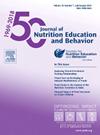粮食安全变化与EFNEP规划核心方面的关联:路径分析。
IF 2.3
3区 医学
Q2 EDUCATION, SCIENTIFIC DISCIPLINES
引用次数: 0
摘要
目的:本研究考察了扩大食品和营养教育计划(EFNEP)中“明智饮食,积极饮食”课程对参与者食品安全的影响,并确定了影响食品安全的途径,以提高计划的有效性。设计:横断面、定量的二次数据。参与者:200名成年EFNEP参与者,他们在2022和2023财政年度完成了所需的计划前和计划后调查。主要结果测量:食品安全、食品资源管理和食品安全。分析:描述性统计总结了参与者的特征。配对t检验评估计划前和计划后的变化。采用结构方程模型进行通径分析,以检验EFNEP领域的改善与参与者粮食安全之间的假设关系。结果:虽然所有EFNEP领域(营养行为、身体活动行为、食品安全和食品资源管理)都有显著改善,但只有51.5%的参与者报告在参与该计划后食品安全得到改善。改善粮食资源管理和食品安全有助于改善粮食安全(β = 0.33和β = 0.28);P < 0.001)。结论和影响:研究结果表明,需要在这些领域之外整合明确的粮食安全战略,以进一步加强项目后的粮食安全改善。本文章由计算机程序翻译,如有差异,请以英文原文为准。
The Association Between Changes in Food Security and Core Aspects of EFNEP Programming: A Path Analysis
Objective
This study examined the impact of the Eating Smart, Being Active curriculum within the Expanded Food and Nutrition Education Program (EFNEP) on participants’ food security and identified the pathways influencing food security to enhance program effectiveness.
Design
Cross-sectional, quantitative secondary data.
Participants
Two hundred adult EFNEP participants who completed the required preprogram and postprogram surveys during fiscal years 2022 and 2023.
Main Outcome Measure(s)
Food security, food resource management, and food safety.
Analysis
Descriptive statistics summarized participants’ characteristics. Paired t tests evaluated preprogram and postprogram changes. Path analysis was conducted using structural equation modeling to test hypothesized relationships between improvements in EFNEP domains and participants’ food security.
Results
While all EFNEP domains (nutrition behaviors, physical activity behaviors, food safety, and food resource management) showed significant improvements, only 51.5% of participants reported improved food security after program participation. Improvements in food resource management and food safety contributed to improved food security (β = 0.33 and β = 0.28, respectively; P < 0.001).
Conclusions and Implications
The findings suggest a need to integrate explicit food security strategies beyond these areas to further enhance postprogram food security improvements.
求助全文
通过发布文献求助,成功后即可免费获取论文全文。
去求助
来源期刊
CiteScore
4.20
自引率
11.50%
发文量
379
审稿时长
44 days
期刊介绍:
The Journal of Nutrition Education and Behavior (JNEB), the official journal of the Society for Nutrition Education and Behavior, is a refereed, scientific periodical that serves as a global resource for all professionals with an interest in nutrition education; nutrition and physical activity behavior theories and intervention outcomes; complementary and alternative medicine related to nutrition behaviors; food environment; food, nutrition, and physical activity communication strategies including technology; nutrition-related economics; food safety education; and scholarship of learning related to these areas.
The purpose of JNEB is to document and disseminate original research and emerging issues and practices relevant to these areas worldwide. The Journal of Nutrition Education and Behavior welcomes evidence-based manuscripts that provide new insights and useful findings related to nutrition education research, practice and policy. The content areas of JNEB reflect the diverse interests in nutrition and physical activity related to public health, nutritional sciences, education, behavioral economics, family and consumer sciences, and eHealth, including the interests of community-based nutrition-practitioners. As the Society''s official journal, JNEB also includes policy statements, issue perspectives, position papers, and member communications.

 求助内容:
求助内容: 应助结果提醒方式:
应助结果提醒方式:


